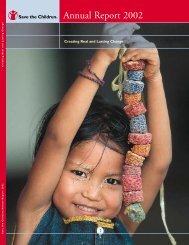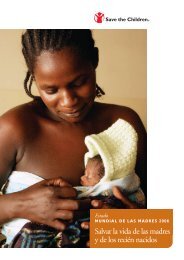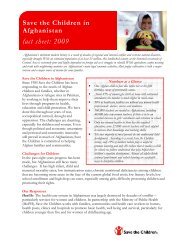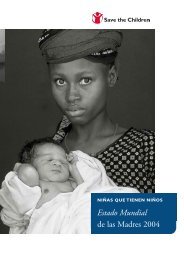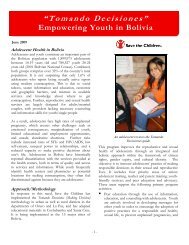Adolescent Sexual and Reproductive Health Toolkit for - UNFPA
Adolescent Sexual and Reproductive Health Toolkit for - UNFPA
Adolescent Sexual and Reproductive Health Toolkit for - UNFPA
You also want an ePaper? Increase the reach of your titles
YUMPU automatically turns print PDFs into web optimized ePapers that Google loves.
MISP: <strong>Adolescent</strong>s <strong>and</strong> <strong>Sexual</strong> Violence Fact Sheet<br />
Why is sexual violence important<br />
to consider <strong>for</strong> adolescents in<br />
emergency settings?<br />
During an acute emergency, incidents of sexual<br />
violence, including rape, sexual abuse <strong>and</strong> sexual<br />
exploitation, are likely to increase. <strong>Adolescent</strong>s who<br />
are faced with poverty or separation from their<br />
families or communities as a result of an emergency<br />
situation are at risk of sexual violence. They may be<br />
coerced to provide sex in exchange <strong>for</strong> food, clothing,<br />
security, or other necessities, or they may sell sex to<br />
earn money <strong>for</strong> what they or their families need.<br />
<strong>Adolescent</strong> girls, especially if they are unaccompanied<br />
or have the responsibility of caring <strong>for</strong> younger<br />
siblings, are at risk of rape <strong>and</strong> SEA because of their<br />
dependence on others <strong>for</strong> survival, because of their<br />
limited decision-making power, <strong>and</strong> because of their<br />
limited ability to protect themselves. 14 In addition,<br />
young girls may be subject to <strong>for</strong>ced early marriage<br />
or trafficking by their families because of economic<br />
hardship. Existing sex- <strong>and</strong> age-related power disparities<br />
may become more prominent in an emergency<br />
setting. Despite the social upheaval that occurs<br />
during a crisis, adolescent girls may be expected to<br />
sustain cultural norms, such as modesty <strong>and</strong> virginity;<br />
if they fail to do so, they are at risk of violence from<br />
men within their homes or the community.<br />
<strong>Adolescent</strong> girls are particularly vulnerable to<br />
sexual violence:<br />
• during conflict, when rape may used as a method<br />
of war;<br />
• during conflict, when adolescent girls may be <strong>for</strong>ced<br />
to become child soldiers or sex slaves;<br />
• during displacement from their homes of origin;<br />
• while collecting water or firewood;<br />
• in unsecured or unprotected sanitation or<br />
bathing facilities;<br />
• at the h<strong>and</strong>s of military, peacekeepers, humanitarian<br />
workers or community members (this includes both<br />
sexual assault <strong>and</strong> sexual exploitation).<br />
Although the majority of GBV survivors are women<br />
<strong>and</strong> girls, men <strong>and</strong> boys can also be subjected to<br />
sexual violence. Marginalized adolescents, such as<br />
those with disabilities, migrants, <strong>and</strong> indigenous<br />
adolescents among others are also at risk of SEA.<br />
What are the consequences of GBV<br />
among adolescents?<br />
<strong>Adolescent</strong> survivors of sexual violence are at risk of<br />
physical injury, STIs including HIV, unwanted pregnancy<br />
<strong>and</strong> unsafe abortion. In addition to physical<br />
injuries, young survivors of sexual violence may suffer<br />
severe mental health <strong>and</strong> psychological problems. It<br />
is common <strong>for</strong> survivors to be blamed <strong>for</strong> the violence<br />
they experience <strong>and</strong>, as a result, they may experience<br />
social stigmatization, be deemed unmarriageable, <strong>and</strong><br />
be rejected by their own families. In certain cultures,<br />
survivors of sexual violence may be seen as having<br />
dishonored their families <strong>and</strong> communities <strong>and</strong>,<br />
there<strong>for</strong>e, may be at risk of “honor killings” at the<br />
h<strong>and</strong>s of their own family members.<br />
What program interventions should<br />
be implemented to address adolescent<br />
GBV in emergency settings?<br />
It is very important that adolescents be considered<br />
<strong>and</strong> specifically targeted <strong>for</strong> program interventions<br />
as the MISP is implemented. Programs should make<br />
ef<strong>for</strong>ts to reach out to those sub-groups who are at<br />
increased risk of sexual violence in emergencies:<br />
orphans, separated adolescents, adolescent heads<br />
of household, marginalized adolescents, <strong>and</strong><br />
children associated with armed <strong>for</strong>ces <strong>and</strong> armed<br />
groups (CAAFAG).<br />
During implementation of the MISP, ASRH program<br />
interventions to support the prevention <strong>and</strong> clinical<br />
management of sexual assault in adolescents include:<br />
• Basic prevention activities: Firewood <strong>and</strong> water<br />
patrols, well-lit paths to latrines <strong>and</strong> bathing<br />
facilities, <strong>and</strong> secure <strong>and</strong> sex-segregated latrine<br />
<strong>and</strong> bathing facilities should be introduced. Safe<br />
sleeping arrangements should be ensured, especially<br />
<strong>for</strong> orphans <strong>and</strong> separated adolescents.<br />
Temporary collective centers must be segregated<br />
by sex <strong>and</strong> age.<br />
<strong>Adolescent</strong>-Inclusive Implementation of the misp<br />
29


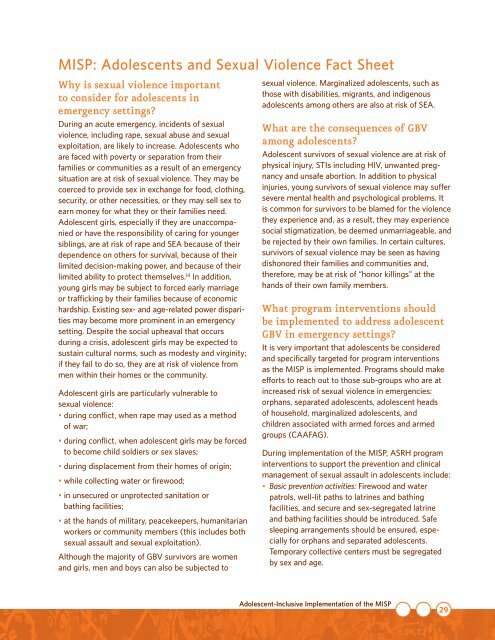

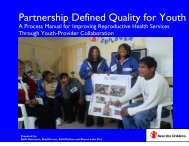

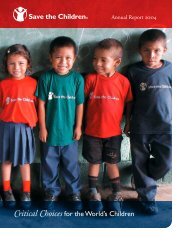
![View full document [PDF 3.39 MB] - PreventionWeb](https://img.yumpu.com/27308954/1/190x245/view-full-document-pdf-339-mb-preventionweb.jpg?quality=85)
